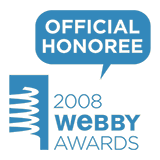Emdashes—Modern Times Between the Lines
The Basics:
About Emdashes | Email us
Ask the Librarians
Best of Emdashes: Hit Parade
A Web Comic: The Wavy Rule
Features & Columns:
Headline Shooter
On the Spot
Looked Into
Sempé Fi: Cover Art
The Way We Live Now
Filed under: Personal Tagged: clips, copywriting, criticism, Emily Gordon, journalism, New Yorker, poet, poetry, portfolio, Print magazine, reviews
Here’s a long-winded description of me if you’re here for the first time: I’m a writer, editor, and digital strategist; my keenest interests are books and culture, politics and social issues, technology and design. I was a staff theater critic for Time Out Chicago; here are those reviews. As a book critic and feature writer, I’ve interviewed Edward Gorey, Aisha Tyler, J. K. Rowling, Lewis Lapham, Ayaan Hirsi Ali, Nick Hornby, Cathleen Schine, Françoise Mouly, Paul Auster, and gifted young designers, among many others. (continued)
Interview: Frankie Manning, Lindy Hop Legend (Newsday)
Filed under: Personal Tagged: clips, dance, Frankie Manning, interviews, lindy hop, Marx Brothers, swing, Whitey's Lindy Hoppers
He Put the Hop in the Lindy | Frankie Manning, the Last King of Swing
By Emily Gordon and Robert L. Fouch
Imagine this scene: In a packed ballroom, hundreds of women edge closer to the dance floor, angling for a chance with that handsome fellow with the brilliant smile, the one who moves with such power and grace. Never mind that the man is 85 years old. This is the legend of lindy, the king of Harlem’s Savoy Ballroom in its heyday, who danced for royalty and has sidestepped old age as he would another couple on the floor. This is Frankie Manning, and as the song begins to swing, the women clamor to be one of his 85 partners—one for each of Manning’s remarkable years.
(continued)Writing About Poetry
Filed under: Personal Tagged: books, clips, in memoriam, Newsday, poetry, The Nation
Reviews:
Poetry Without Pain: National Poetry Month roundup (Newsday)
How to Read a Poem: And Fall in Love With Poetry, by Edward Hirsch
How to Read a Poem…And Start a Poetry Circle, by Molly Peacock
A Grain of Poetry: How to Read Contemporary Poems and Make Them Part of Your Life, by Herbert Kohl
Poetry Anthologies After September 11 (Newsday)
Poetry After 9/11: An Anthology of New York Poets, ed. Dennis Loy Johnson and Valerie Merians
110 Stories: New York Writes After September 11, ed. Ulrich Baer
Poems of New York, ed. Elizabeth Schmidt
Speaking From Memory (Newsday)
Handwriting: Poems, by Michael Ondaatje
Above an Abyss (The Nation)
Meadowlands, by Louise Glück
Otherwise: New and Selected Poems, by Jane Kenyon
Pollitt, Poet (The Nation)
The Mind-Body Problem: Poems, by Katha Pollitt
Obituaries:
Ted Hughes (Newsday)
Iris Murdoch (Newsday)
Review: Poetry Without Pain (Newsday)
Filed under: Clips Tagged: books, clips, Edward Hirsch, Herbert Kohl, Molly Peacock, Newsday, poetry, reviews
Poetry Without Pain | Averse to verse? Good! For National Poetry Month, here are three books to stir the stanza lover in you.
By Emily Gordon
HOW TO READ A POEM: And Fall in Love With Poetry, by Edward Hirsch. Harcourt Brace, 352 pp., $23.
HOW TO READ A POEM…And Start a Poetry Circle, by Molly Peacock. Riverhead, 209 pp., $22.95.
A GRAIN OF POETRY: How to Read Contemporary Poems and Make Them Part of Your Life, by Herbert Kohl. HarperCollins, 175 pp., $23.
Otherwise sensible people are always going around saying they don’t like poetry. Not “Emily Dickinson perplexes me” or “haikus give me the heebie-jeebies”; nope, they tried it, and it didn’t agree with them. “It’s just not my thing,” they say with inexplicable pride, as though staking a claim for verbal democracy. Often, these are folks who savor words and delight in the pleasures of reading. Yet somehow they can justify dismissing a whole genre of literature, which spans thousands of years and countless phases of human creativity, out of hand. You don’t hear anyone declaring that they’ve never really seen the point of paintings, or “This Gustav Mahler—why doesn’t he just come out and say what he means?” So why is poetry so scary?
(continued)Interview: Nick Hornby (Newsday)
Filed under: Personal Tagged: About a Boy, Arsenal, books, fiction, High Fidelity, Newsday, Nick Hornby, reviews
A Fan’s Notes
By Emily Gordon
“For the first, but certainly not the last, time, I began to believe that Arsenal’s moods and fortunes somehow reflected my own,” wrote Nick Hornby in “Fever Pitch,” a memoir of his obsession with his local English soccer team. At the time, this proved to be a faulty theory, but today it seems perfectly apt. Just as Arsenal captures the soccer grail - winning the league championship and the FA Cup in the same season (“an event that’s happened only six times this century,” he reports) - Hornby is scoring writerly goals with his new novel, “About a Boy” (Riverhead, $22.95). On a tour wedged into the off-season, ending just before the World Cup, Hornby stopped to talk at lunch in New York.
(continued)











